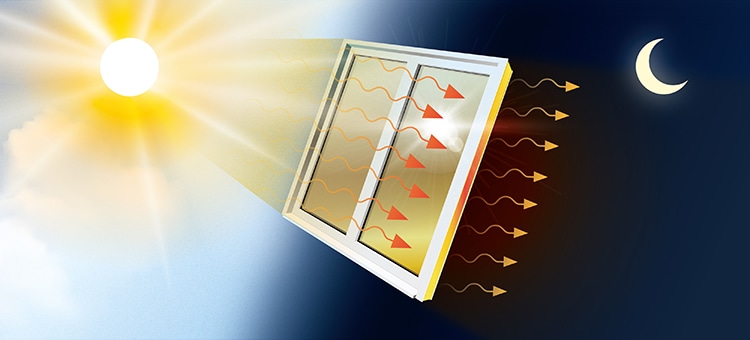Jul 9 2019
A window film designed using a particular molecule is likely to take the edge off the worst midday heat and distribute it evenly from morning to evening.
 The molecule captures energy from the sun and releases it later as heat. (Image credit: Yen Strandqvist/Chalmers)
The molecule captures energy from the sun and releases it later as heat. (Image credit: Yen Strandqvist/Chalmers)
Scientists from the Chalmers University of Technology, Sweden, have reported in Advanced Science, a scientific journal, that the molecule has the incredible potential to absorb energy from the sun’s rays and later emit it as heat.
During sunny summer days, it can be almost unbearable to stay at home or in cars. The heat that radiates indoors creates a horrible high temperature for animals, people, and plants. The use of energy-intensive systems like fans and air conditioning implies that other energy forms are used to combat the heat energy.
Scientists at the Chalmers University of Technology have suggested a method that can alternatively use the heat and distribute it evenly over a prolonged period.
When the exclusively developed molecule was hit by the rays from the sun, it captured photons and at the same time transformed—it was isomerized. When there is no sunshine on the window film, the molecules can emit heat for up to eight hours after sunset.
The aim is to create a pleasant indoor environment even when the sun is at its hottest, without consuming any energy or having to shut ourselves behind blinds. Why not make the most of the energy that we get free of charge instead of trying to fight it.
Kasper Moth-Poulsen, Chemist and Study Lead Author, Chalmers University of Technology
At daybreak when the film has not yet absorbed any solar energy, it is either yellow or orange as these colors are the opposite of green and blue, which is the light spectrum selected by the scientists to capture from the sun. Upon absorbing solar energy and becoming isomerized, the molecule loses its color and later becomes fully transparent.
Until the sun is bright, the film traps energy, meaning that not as much heat enters the film and into the room. At twilight, when there is less sunlight, heat is emitted from the film. Eventually, the film returns to its yellow shade and is ready to capture the sunlight again the next day.
For example, airports and office complexes should be able to reduce their energy consumption while also creating a more pleasant climate with our film, since the current heating and cooling systems often do not keep up with rapid temperature fluctuations.
Kasper Moth-Poulsen, Chemist and Study Lead Author, Chalmers University of Technology
The molecule is part of an idea the scientists describe as MOST, acronym for “Molecular Solar Thermal Storage.” The researches have previously presented an energy system for houses based on such molecule. In such case—once the solar energy is captured by the molecule—it could be stored for a prolonged period, that is, from summer to winter, and then used to heat the whole house.
The scientists figured out that they were also able to shorten the steps to application by optimizing the molecule for a window film, which could lead to better conditions for the somewhat more complex energy system for houses.
They are yet to increase the molecule’s concentration in the film without changing the properties of the film and reduce the cost of the molecule. However, as stated by Moth-Poulsen, they are about to achieve this innovation.
“The step to applying our film is so short that it could happen very soon. We are at a very exciting stage with MOST,” remarked Moth-Poulsen.
Window film could even out the indoor temperature using solar energy
Timelapse video showing what the technology could look like. (Video credit: Mats Tiborn, Johan Bodell/Chalmers)